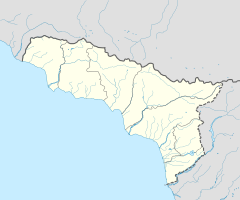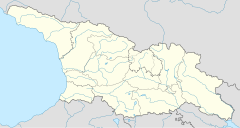Gagra church
| Church of Gagra გაგრის ეკლესია(in Georgian) Гагратәи ауахәама (in Abkhaz) | |
|---|---|
 Church of Gagra | |
| Religion | |
| Affiliation | Georgian Orthodox |
| Province | Abkhazia[1] |
| Year consecrated | 6th century |
| Status | active |
| Location | |
| Location | |
| Municipality | Gagra |
| Geographic coordinates | 43°19′31″N 40°13′25″E / 43.32528°N 40.22361°E |
The Gagra Church (Georgian: გაგრის ეკლესია, romanized: gagris ek'lesia, Abkhaz: Гагратәи ауахәама), also known as Abaata, is an Early Medieval Christian church at Gagra in Abkhazia, Georgia. One of the oldest churches in Abkhazia, it is a simple three-nave basilica built in the 6th century by Anchabadze dynasty. It was reconstructed in 1902.[2]
History
The Gagra church stands in the territory of the contemporaneous fortress known as Abaata, which was also built by Anchabadze dynasty in the 4th-5th AD ruling dynasty in Abkhazia ( Georgia) at the time. The fortress is now completely in ruins.
It is built of blocks of rough ashlar stone, the main entrance is from the westerly located narthex. All three naves are connected with each other via doors. The main nave is lit through three windows in the southern wall and with one window, each on the western wall and in the altar. The design of the church is surrounded by “Bolnuri” crosses, which is located on the east door tympanon. The church have many common architectural features with similar basilicas in Eastern Georgia.[3] The church was completely reconstructed in 1902 at the behest of Princess Eugenia Maximilianovna of Leuchtenberg, wife of Duke Alexander Petrovich of Oldenburg, a member of the Russian imperial family, who turned Gagra into a spa town. On 9 January 1903 it was consecrated as the Church of Saint Hypatius.[4] At the same time, the old fortress of Abaata was demolished to pave way to the construction of a hotel. In the Soviet era, the church building was used as a museum of old weaponry. The church underwent some renovation in 2007 and it was restored to Christian use in 2012.[citation needed]
The Gagra church is inscribed on Georgia's list of Monuments of National Significance.[3]
References
- ^ The political status of Abkhazia is disputed. Having unilaterally declared independence from Georgia in 1992, Abkhazia is formally recognised as an independent state by 5 UN member states (two other states previously recognised it but then withdrew their recognition), while the remainder of the international community recognizes it as as de jure Georgian territory. Georgia continues to claim the area as its own territory, designating it as Russian-occupied territory.
- ^ Basilica in old Gagra town Historical monuments of Abkhazia — Government of the Autonomous Republic of Abkhazia.
- ^ a b Gelenava, Irakli, ed. (2015). Cultural Heritage in Abkhazia (PDF). Tbilisi: Meridiani. p. 14.
- ^ Гагры. Климатическая станция на Черноморском побережье [Gagry, a climate spa on the Black Sea coast] (PDF) (in Russian). St. Petersburg. 1905. p. 8.
{{cite book}}: CS1 maint: location missing publisher (link)
- CS1 maint: location missing publisher
- CS1 Russian-language sources (ru)
- Articles with short description
- Short description matches Wikidata
- Articles with Georgian-language sources (ka)
- Articles with Abkhaz-language sources (ab)
- Coordinates on Wikidata
- Articles containing Georgian-language text
- Articles containing Abkhaz-language text
- All articles with unsourced statements
- Articles with unsourced statements from December 2020
- Churches in Abkhazia
- 6th-century churches
- Immovable Cultural Monuments of National Significance of Georgia

